Adobong Pula, an Ilonggo interpretation of the Philippines' national dish, showcases the rich diversity of regional Filipino cuisine. This distinctive version from Iloilo transforms the classic adobo by incorporating atsuete (annatto) and fresh ginger, creating a vibrant red sauce that sets it apart from its traditional counterpart.
The slow-cooking process ensures the pork ribs become fork-tender while absorbing the rich flavors of the sauce, resulting in a dish that honors traditional adobo techniques while offering a unique regional perspective. Perfect for both everyday meals and special occasions, this Ilonggo Adobong Pula demonstrates how local ingredients and cooking traditions can elevate a beloved national dish into something remarkably distinctive.
Cultural Notes
Adobong Pula represents the rich culinary heritage of Iloilo, where atsuete is commonly used to give dishes their characteristic red color. This version demonstrates how regional variations can transform a national dish while maintaining its essence.
Jump to:
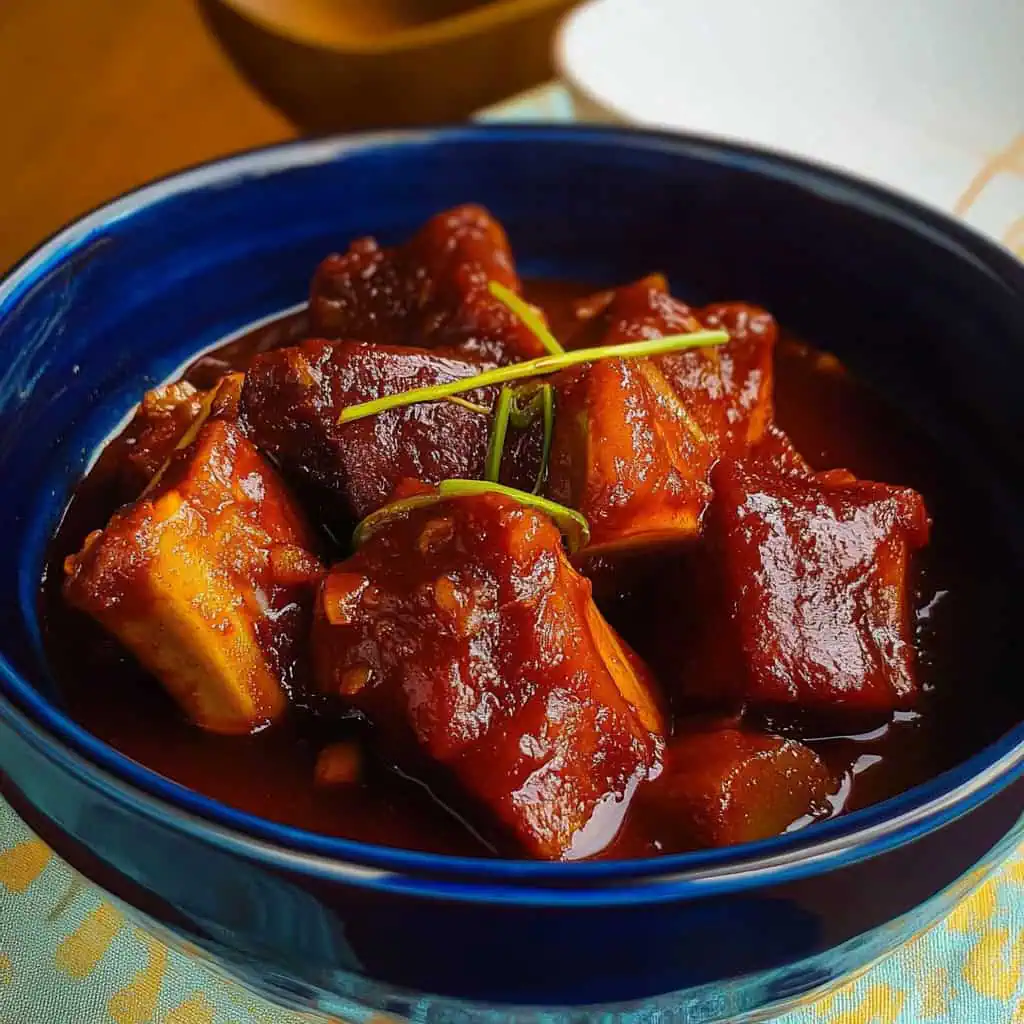
Why You'll Love This Recipe
- Rich Heritage: Experience an authentic Ilonggo variation of the Philippines' national dish
- Unique Flavor Profile: The addition of atsuete (annatto) and ginger creates a distinct taste that sets it apart from traditional adobo
- Make-Ahead Friendly: Tastes even better the next day as flavors continue to develop
- One-Pot Wonder: Minimal cleanup required
- Budget-Friendly: Uses affordable cuts of pork that become tender through slow cooking
Ingredients
Each element in this recipe plays a crucial role in creating authentic Ilonggo Adobong Pula. The fatty pork ribs provide rich flavor and become tender through slow cooking. Aromatics like garlic, onion, and ginger form the flavor base, while atsuete gives the dish its signature red color.
The palm vinegar and soy sauce create the classic adobo tang with a perfect balance of acidity and saltiness. Bay leaves add subtle depth, and brown sugar rounds out the flavors by cutting through the sharpness of the vinegar.
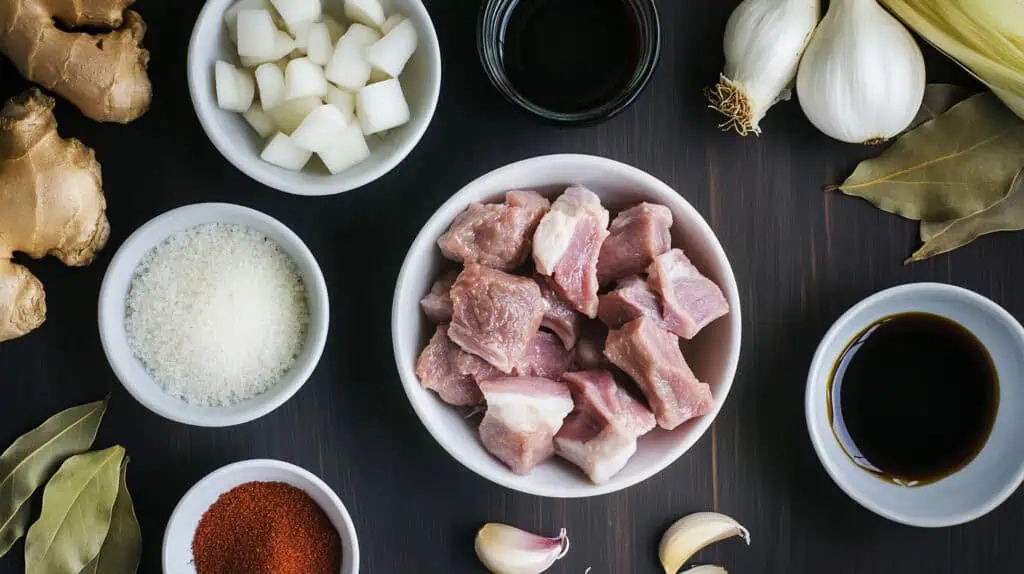
- 2 pounds pork belly with ribs or spare ribs, cut into 2-inch pieces
- 1 tablespoon canola oil
- 1 medium onion, peeled and chopped
- 6 cloves garlic, peeled and minced
- 1 thumb-sized ginger, peeled and minced
- 2 bay leaves
- 1 tablespoon atsuete powder
- 1 cup palm vinegar
- ½ cup soy sauce
- 1 cup water
- 1 tablespoon brown sugar
- Salt and pepper to taste
Equipment
- Large Heavy-Bottom Pot (Kaldero): Essential for even heat distribution and preventing the sauce from burning during the long simmering process
- Sharp Knife: For cutting meat into uniform pieces, ensuring even cooking
- Wooden Spoon: Prevents scratching your pot and is perfect for the gentle stirring needed in this recipe
- Measuring Cups and Spoons: For precise ingredient proportions, especially important for the vinegar-soy sauce balance
- Meat Thermometer: Helps ensure the pork reaches the ideal tenderness (internal temperature of 165°F)
- Strainer: If using whole atsuete seeds instead of powder, this helps extract the color efficiently
- Small Bowl: For preparing the atsuete powder if needed
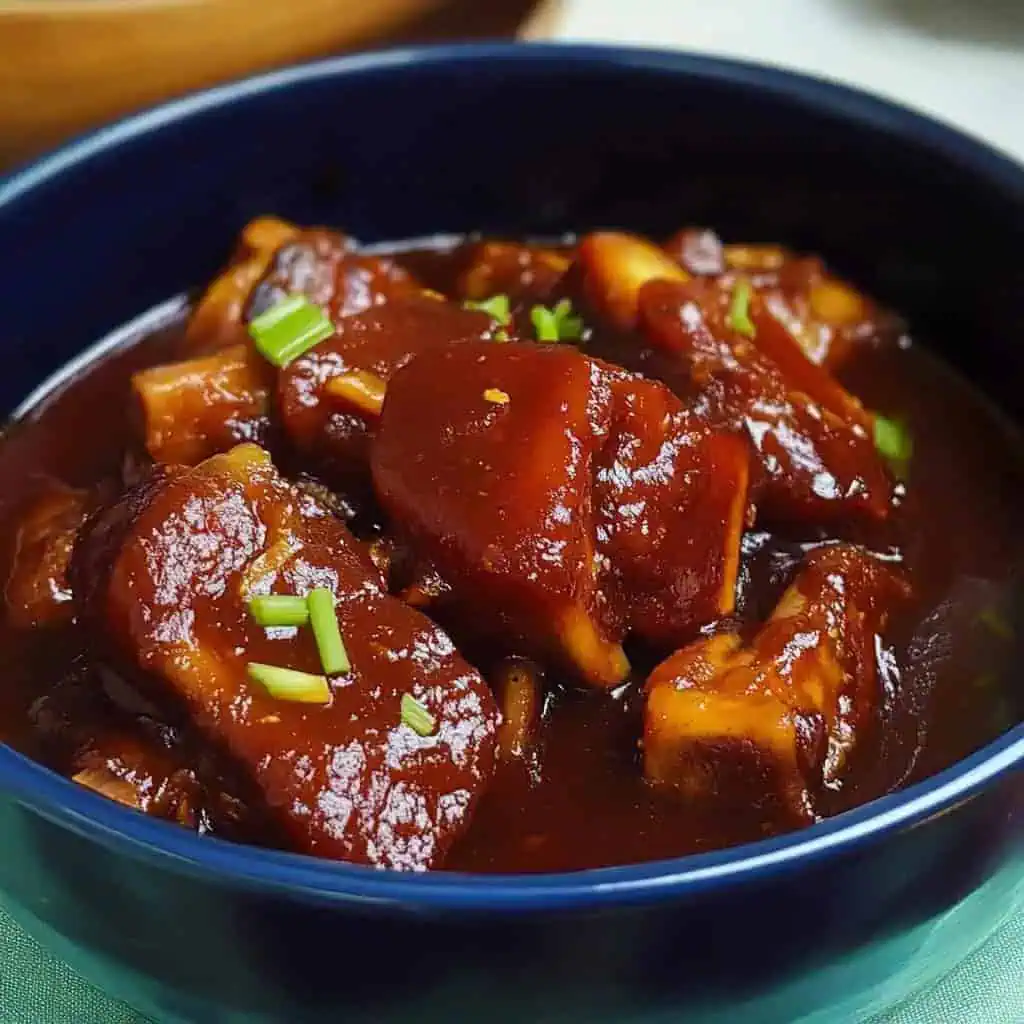
How To Make
- Start by patting the pork pieces dry with paper towels and cutting them into 2-inch pieces. Peel and chop the onion, mince the garlic cloves, and finely mince the ginger.
- Heat a large pot over medium heat and add the oil. Once hot, add the chopped onions, minced garlic, and minced ginger. Cook them while stirring until they become soft and fragrant, about 3-4 minutes.
- Add the pork ribs to the pot and cook for 3-5 minutes until they turn light brown. Make sure all sides are evenly browned.
- Sprinkle the atsuete powder over the meat and stir until all the pork pieces are evenly coated with the red color.
- Pour in the vinegar and let it come to a boil. Very important: do not stir for the first 3-5 minutes after adding the vinegar. This helps cook off the sharp vinegar taste.
- Add the soy sauce and water to the pot. Let it come to a boil, then skim off any foam that rises to the top. Drop in the bay leaves.
- Lower the heat to a gentle simmer, cover the pot, and cook for about 40-50 minutes. Check occasionally - the meat is ready when you can easily pierce it with a fork.
- Once the meat is tender, stir in the brown sugar until it dissolves. Taste the sauce and add salt and pepper as needed.
- Let the adobo rest for 5-10 minutes before serving. The sauce will thicken slightly as it cools. Serve hot with steamed rice.

Tips from Lola's Kitchen
- Quality Ingredients Matter: Use fresh, high-quality pork ribs for the best flavor and texture. Look for meat with a good fat-to-meat ratio for maximum tenderness.
- Proper Meat Temperature: Always start with room temperature meat for even cooking. Take the pork out of the refrigerator 30 minutes before cooking.
- The Browning Secret: Never rush the browning process – this builds the foundation of flavor. Take your time to develop a nice caramelization on the meat.
- Vinegar Technique: Let the vinegar boil untouched for 3-5 minutes to mellow its sharpness. This step is crucial for balancing the final flavor profile.
- Atsuete Extraction: If using whole atsuete seeds instead of powder, soak them in warm oil for 5-10 minutes before straining. Save this flavored oil for other Filipino dishes.
- Low and Slow: Resist the urge to rush the cooking process. The magic happens during the slow simmer when the meat becomes tender and the flavors meld together.
- Overnight Magic: For best results, make this dish a day ahead and refrigerate overnight. The flavors will deepen significantly by the next day.
Substitutions
- Meat Options: Chicken can be substituted (reduce cooking time to 45 minutes) or beef (increase to 2 hours). Pork shoulder also works well in this recipe.
- Vinegar Alternatives: If palm vinegar isn't available, use apple cider vinegar or white vinegar, but reduce the amount by 25% as they tend to be sharper.
- Atsuete Substitutes: Paprika can work in a pinch, but use half the amount and know that the flavor profile will be slightly different.
- Soy Sauce Replacements: Liquid aminos or coconut aminos can be used for a gluten-free option, though you may need to adjust the salt accordingly.
- Sweetener Options: Muscovado sugar, honey, or coconut sugar all work well in place of brown sugar, each adding their own subtle nuances.
Troubleshooting
- Meat Too Tough: Continue cooking on low heat, adding more water if needed. Tough meat usually means it needs more time to break down the connective tissues.
- Sauce Too Salty: Add a quartered potato to absorb excess salt, or dilute with a little water and a splash more vinegar to rebalance flavors.
- Sauce Too Sour: Add more brown sugar gradually, tasting as you go. A pinch of baking soda can also help neutralize excessive acidity.
- Color Not Red Enough: Add more atsuete powder mixed with a little oil and incorporate it gently into the sauce. Let it simmer for a few more minutes to develop the color.
- Sauce Too Thin: Simmer uncovered for 10-15 more minutes to reduce and thicken. If needed, you can also add a slurry of 1 teaspoon cornstarch mixed with 1 tablespoon cold water.
Storage & Reheating
- Refrigeration: Store in an airtight container for 3-4 days. The flavor actually improves after a day in the refrigerator.
- Freezing: Portion into freezer-safe containers and freeze for up to 3 months. Thaw overnight in the refrigerator before reheating.
- Stovetop Reheating: Place in a pot over low heat with a splash of water to prevent drying out. Heat slowly, stirring occasionally until the internal temperature reaches 165°F.
- Microwave Reheating: Use 2-3 minute intervals at medium power, stirring between each interval. Cover loosely to prevent splattering.
- Serving After Storage: A fresh garnish of sliced green onions or a sprinkle of toasted garlic bits can refresh the dish after reheating.
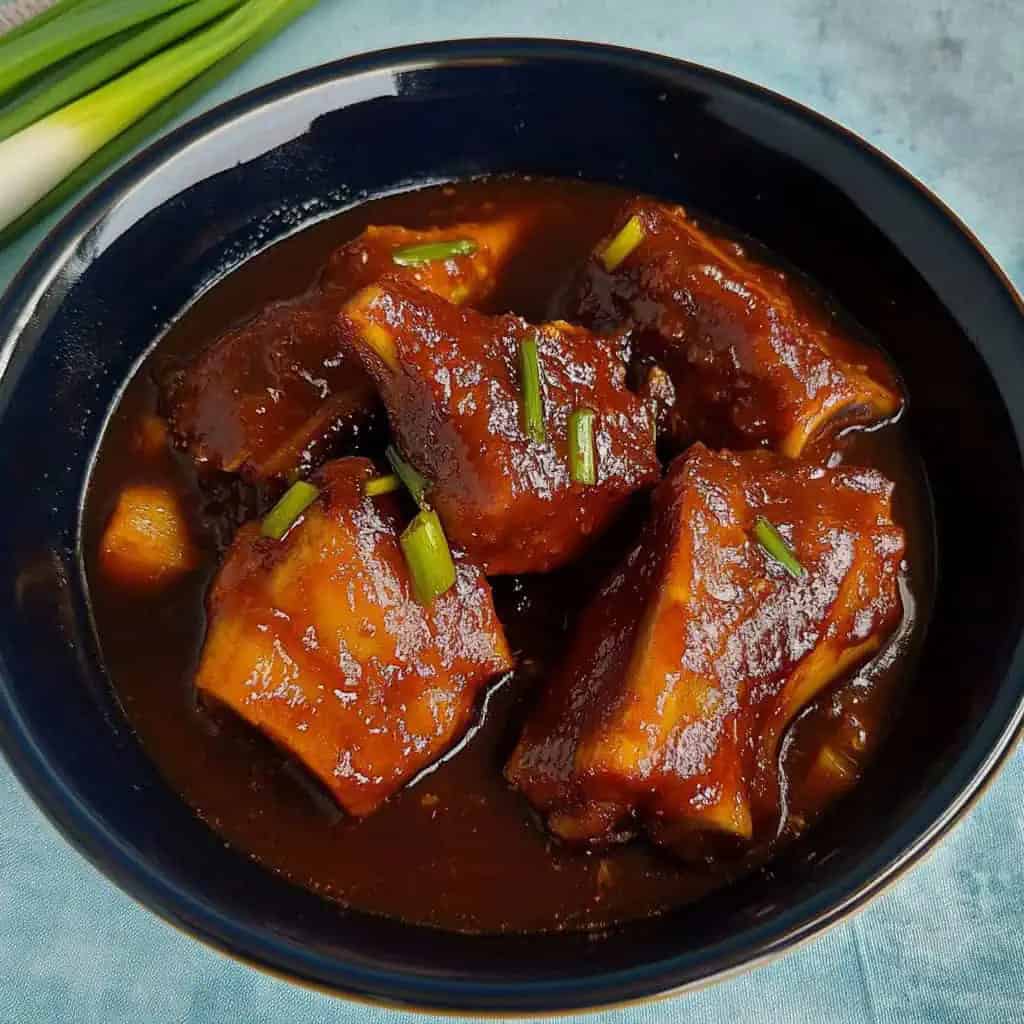
FAQ
Why is my adobo not turning red?
Ensure you're using fresh atsuete powder and enough oil to properly distribute the color. If using whole seeds, they might need more time to release their color. Heat helps activate the coloring properties of atsuete.
Can I cook this in a slow cooker?
Yes, brown the meat and aromatics first, then transfer to a slow cooker with the remaining ingredients. Cook on low for 6-8 hours until the meat is fork-tender.
Is this dish spicy?
Traditional Ilonggo Adobong Pula is not spicy. However, you can add bird's eye chilies (siling labuyo) during cooking or as a garnish if you prefer heat.
How do I know when the meat is done?
The meat should easily separate when prodded with a fork. For food safety, the internal temperature should reach at least 165°F (74°C).
Can I make this ahead for a party?
Definitely! This dish actually tastes better the next day as the flavors continue to develop. Reheat gently before serving.
What makes this different from regular adobo?
The distinctive red color from atsuete and the addition of ginger sets Ilonggo Adobong Pula apart from the standard soy sauce-based adobo common throughout the Philippines.
Can I use a pressure cooker to speed up cooking?
Yes, after browning the meat and adding all ingredients, cook under pressure for about 25-30 minutes with a natural release for tender results.
What sides pair well with this dish?
Traditional accompaniments include steamed white rice, green mango salad (ensaladang mangga), pickled papaya (atchara), or banana heart salad (ensaladang puso ng saging).
Related
Looking for other recipes like this? Try these:
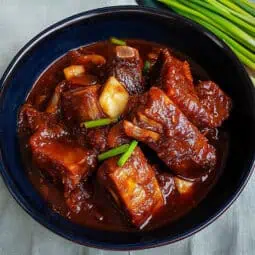
Ilonggo Pork Ribs Adobo with Atsuete (Adobong Pula)
Equipment
- Large Heavy-Bottom Pot (Kaldero) For even heat distribution and preventing burning
- Sharp knife (matalim na kutsilyo) For cutting meat into uniform pieces
- Wooden spoon (sandok na kahoy) To avoid scratching the pot and for better stirring
- Measuring cups and spoons (Panukat) For accurate ingredient portions
- Meat thermometer To ensure proper cooking temperature
- Strainer (Optional) For extracting atsuete from seeds if using whole seeds
Ingredients
For the Meat
- 2 pounds pork belly with ribs or spare ribs Liempo, cut into 2-inch pieces
- 1 tablespoon canola oil Mantika
For the Aromatics
- 1 medium onion Sibuyas, peeled and chopped
- 6 cloves garlic Bawang, peeled and minced
- 1 thumb-sized ginger Luya, peeled and minced
- 2 bay leaves Dahon ng Laurel
For the Sauce
- 1 tablespoon atsuete powder Achuete/Annatto
- 1 cup palm vinegar
- ½ cup soy sauce Toyo
- 1 cup water Tubig
- 1 tablespoon brown sugar Asukal na Pula
- Salt Asin at Paminta to taste
Instructions
- Start by patting the pork pieces dry with paper towels and cutting them into 2-inch pieces. Peel and chop the onion, mince the garlic cloves, and finely mince the ginger.
- Heat a large pot over medium heat and add the oil. Once hot, add the chopped onions, minced garlic, and minced ginger. Cook them while stirring until they become soft and fragrant, about 3-4 minutes.
- Add the pork ribs to the pot and cook for 3-5 minutes until they turn light brown. Make sure all sides are evenly browned.
- Sprinkle the atsuete powder over the meat and stir until all the pork pieces are evenly coated with the red color.
- Pour in the vinegar and let it come to a boil. Very important: do not stir for the first 3-5 minutes after adding the vinegar. This helps cook off the sharp vinegar taste.
- Add the soy sauce and water to the pot. Let it come to a boil, then skim off any foam that rises to the top. Drop in the bay leaves.
- Lower the heat to a gentle simmer, cover the pot, and cook for about 40-50 minutes. Check occasionally - the meat is ready when you can easily pierce it with a fork.
- Once the meat is tender, stir in the brown sugar until it dissolves. Taste the sauce and add salt and pepper as needed.
- Let the adobo rest for 5-10 minutes before serving. The sauce will thicken slightly as it cools. Serve hot with steamed rice and enjoy your homemade Adobong Pula.
- Remember: If the sauce becomes too thick while cooking, you can add a little hot water. If it's too thin, simmer uncovered for a few extra minutes until it reaches your desired consistency.
Tips from Lola's Kitchen
- Always use room temperature meat for even cooking
- Never rush the browning process - it builds flavor
- Let the vinegar boil untouched to cook off the sharp acidic taste
- If using whole atsuete seeds, soak in warm water for 5 minutes before straining
- Save the atsuete-infused oil for other Filipino dishes
Nutrition
The Story Behind Ilonggo Pork Ribs Adobo with Atsuete (Adobong Pula)
Growing up in the sun-drenched provinces of the Philippines, adobo has always been more than just a dish - it's a testament to our culinary heritage. While most Filipinos are familiar with the classic dark-hued adobo, the vibrant Ilonggo Adobong Pula (Red Adobo) tells a different story of regional innovation and local ingredients.
In the kitchens of Iloilo, where traditional cooking methods meet local ingredients, Adobong Pula emerged as a distinctive variation of our national dish. The addition of atsuete (annatto seeds), a natural food coloring derived from the achiote tree, gives this version its characteristic red hue. This ingredient, brought to the Philippines through centuries of trade, has become deeply integrated into Ilonggo cuisine, particularly in their interpretation of adobo.
What makes this version truly special is how it builds upon the traditional adobo base of vinegar, garlic, and soy sauce. The Ilonggos ingeniously incorporated ginger and atsuete, creating a more complex flavor profile that distinguishes their regional version. The atsuete not only provides the striking red color but also imparts subtle earthy notes that complement the dish's savory-tangy foundation.
Unlike the soy sauce-heavy versions found in other regions, Ilonggo Adobong Pula maintains a delicate balance where no single ingredient overpowers the others. The slow-cooking process allows the pork ribs to become incredibly tender while absorbing the vibrant flavors of the sauce. This cooking method, passed down through generations of Ilonggo families, ensures that each bite delivers the perfect harmony of tastes that has made this version a beloved regional specialty.
Today, this Ilonggo adaptation of adobo stands as a proud example of how local ingredients and cooking traditions can transform a national dish while maintaining its soul. Whether served at family gatherings, fiestas, or everyday meals, Adobong Pula continues to capture the hearts and palates of both locals and visitors to the Western Visayas region, proving that there's always room for innovation in traditional Filipino cuisine.
Keywords naturally integrated: Ilonggo cuisine, Filipino adobo variations, traditional Filipino cooking, regional Filipino dishes, atsuete recipes, Western Visayas food, Filipino pork recipes, authentic Filipino cooking, heritage recipes, Filipino regional cuisine, traditional cooking methods, Filipino food history.
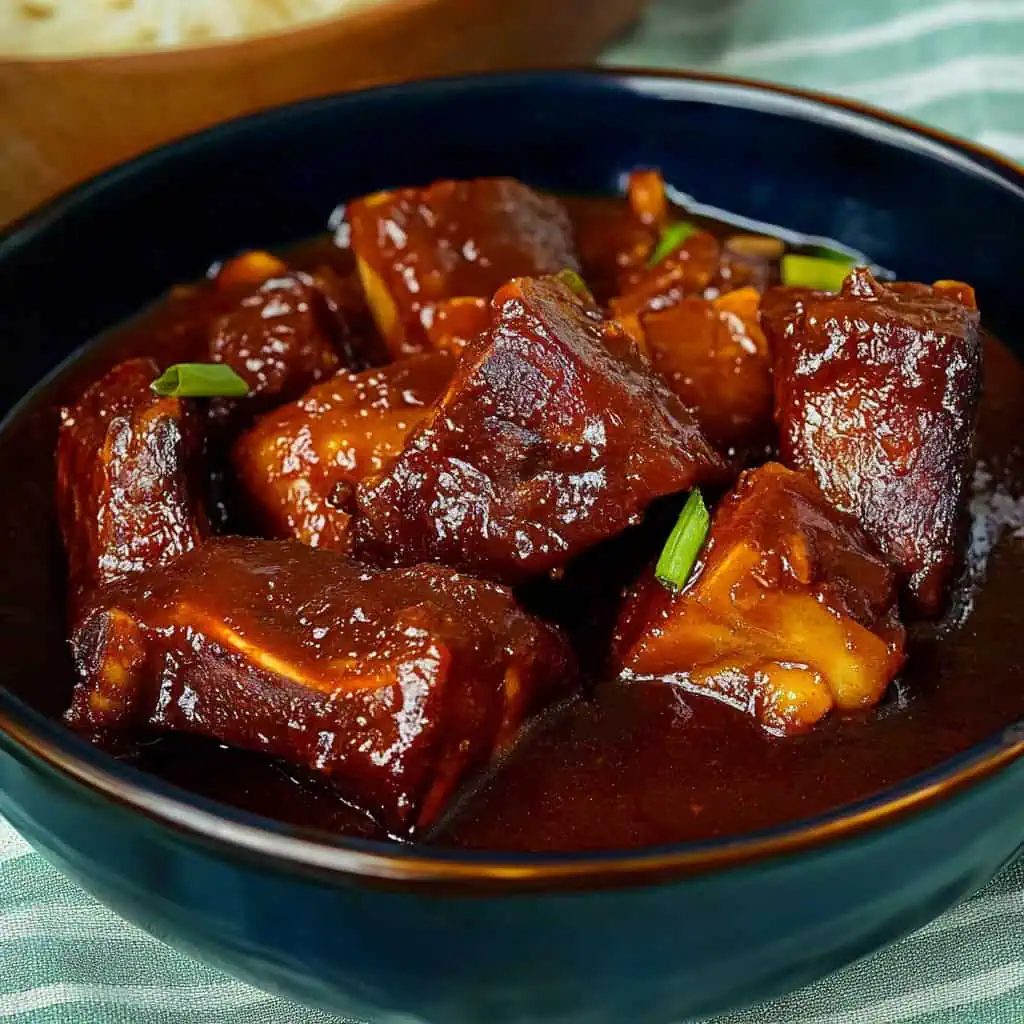









Comments
No Comments